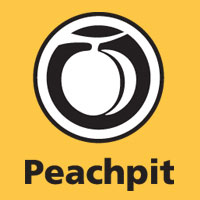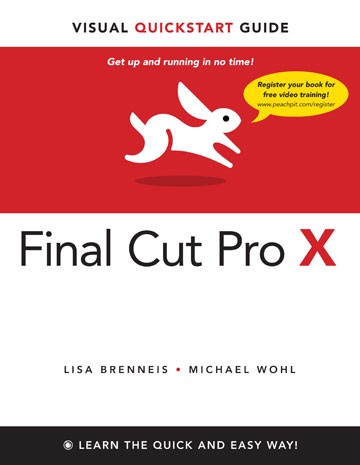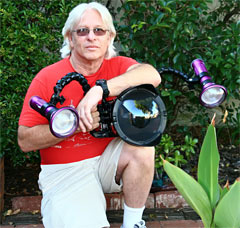
December 12, 2011
by Lisa Brenneis & Michael Wohl
www.peachpit.com - $31.99
Review by Steve Douglas
For the first several versions of legacy Final Cut Pro, the Lisa Brenneis Visual Quick Pro Guides were, without a doubt, the Final Cut Pro reference books to own. They were the ones you kept by your side, and the first to go to when you needed to learn a 'how to' or figure out what went wrong when editing. As Final Cut Pro grew into the versions 6 & 7, the Quick Pro Guides, while still continuing to supply most of the information a user might need, failed to deliver on comprehensive inclusions covering new features. You were instructed to go on-line and navigate to where addendums on these features could be found. I did not care for this, as a quick reference book should be just that; a book where you can quickly go to in order to overcome an editing hurtle without wasting valuable time finding instruction on-line. Good news, things have changed!

Since the release of Apple's new Final Cut Pro X, supplemental DVDs, podcasts and books that have come out focused on learning Final Cut Pro X. Lisa Brenneis, now teaming up with Michael Wohl, reestablishes the newly named Visual Quickstart Guide for Final Cut Pro X as the reference book to have. It's a "Just the facts, ma'am" book once again and much to my satisfaction. Michael Wohl, previously an Apple Final Cut Pro team member, along with Lisa Brenneis cover the entirety of the current Final Cut Pro X in the book's 22 chapters starting from the beginning with how to manage your events, viewing and marking clips, project management and backing up, importing and editing tools, using the new Audition feature, audio editing and effects as well as color correction, using compound clips and retiming. Of course, output, sharing and exporting directions and suggestions are to be found, as would be expected, including uploading to the web.
Every feature that I can see is found and covered in this new Visual Quickstart Guide as well as some I probably haven't discovered yet.
In the tradition of previous QuickPro Guides, each topic covered is demonstrated with step by step methodology accompanied by full color illustrations regarding the subject matter. Along side these are much appreciated 'Tips' numbering in the hundreds that might go a long way to shortening your learning curve and speeding up your workflow. Each 'tip' made sense to me and were enlightening in their own way.
To their credit, I was pleasantly surprised to read the author's notes regarding features that have been included in Final Cut Pro X but are not always helpful. Pointed out is the impreciseness of X's skimming feature and the questionable usefulness of the Viewer's controls for limiting the Viewer's display to only one video channel. And these comments were found in only 1 chapter! I find that observing the negatives as well as the positives in anything allows me to trust the authors more than if I had simply been fed hyperbole.
While I am not a fan of Final Cut Pro X's new Color Board and the eschewing of the legacy version of the 3-way color corrector, the chapter on color correction is not to be missed for its thoroughness moving from the basics of using X's color correction tools right through to applying secondary color correction and using masks to strengthen your imaging results. Unfortunately, I did find that the coverage of using the video scopes to be rather thin. Definitions are included in terms of which scopes do what, but precisely how to use them properly seems to have been left out. For the new editor, especially, learning how to use the video scopes can be invaluable, and I regret that this one area was shortchanged.
Reading the chapter on how markers are used in Final Cut Pro X, which are different than what the editor had in legacy versions of Final Cut Pro, gave me some ideas regarding how to manipulate some its functions so that they fit my editing needs. Another fine chapter.
All in all, this new release from Peachpit meets the high standards and expectations we had and found for early versions of the Quick Pro Guides from Peachpit. No where, that I could find, is it suggested that you go online to find information on tools or features that were left out. It's a complete book, as any reference book should be, and is back in top form. If you are just learning to edit, or are transitioning to Final Cut Pro X, the 'Visual Quickstart Guide: Final Cut Pro X by Michael Wohl and Lisa Brenneis is, once again, the reference book to own.

Steve Douglas is a certified Apple Pro for Final Cut Pro 7 and underwater videographer. A winner of the 1999 Pacific Coast Underwater Film Competition, 2003 IVIE competition, 2004 Los Angeles Underwater Photographic competition, and the prestigious 2005 International Beneath the Sea Film Competition, where he also won the Stan Waterman Award for Excellence in Underwater Videography and 'Diver of the Year', Steve was a safety diver on the feature film "The Deep Blue Sea", contributed footage to the Seaworld Park's Atlantis production, and productions for National Geographic and the History channels. Steve was a feature writer for Asian Diver Magazine and is one of the founding organizers of the San Diego UnderSea Film Exhibition. He is available for both private and group seminars for Final Cut Pro and leads underwater filming expeditions and African safaris with upcoming excursions to Bali, Raja Ampat, Indonesia, and the Maldives Islands. Feel free to contact him if you are interested in joining Steve on any of these exciting trips. www.worldfilmsandtravel.com